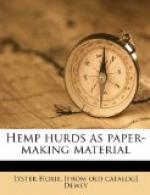[Illustration: Fig. 3.—A representative sample of hemp hurds, natural size, showing hemp fiber and pieces of wood tissue.]
=Character of the material.=
As received from Pierceton, Ind., the hurds consisted of a mixture of tangled hemp bast fibers and pieces of broken wood of the hemp stalk. (Fig. 3.) No reliable data were secured as to the proportion of bast fiber in the total shipment of 4 tons, although two hand separations of small representative samples gave results averaging 8 per cent. The chemical character of the material was such and the quantity was so small that any appreciable variation of the proportion should not affect materially the treating processes finally adopted, yet its presence in varying proportions undoubtedly would modify to some extent the quality of the resulting paper product. Since the length of the ultimate bast fiber averages about 22 mm. and the length of the ultimate hemp wood fiber averages 0.7 mm., it is natural to assume that the bast fiber would tend to increase the strength of paper produced from the hurds. (Fig. 4.)
[Illustration: Fig. 4.—Fiber derived from the woody portion of the hurds. x75. From a microphotograph.]
The broken pieces of wood contained in the hurds varied in length from mere particles which were somewhat finer than sawdust to pieces about 3-1/2 inches long, exceptional pieces being found which measured 6 inches in length. The majority of the long pieces were between 2 and 3 inches in length. In thickness the pieces ranged from one-eighth of an inch, in case they were derived from the base of the hemp stalks, to about one sixty-fourth of an inch in those pieces which were derived from the top and branches of the stalks. In cross section the pieces often were found to be a quarter or half of the rounded rectangular woody shell of the stalk, although there appeared to be no regularity in this respect.
From the pulp-maker’s standpoint the great irregularity in thickness, length, and mass of the woody pieces militates decidedly against economy in pulp production. The smaller pieces reduce by chemical treatment sooner than the larger fragments and are thereby overtreated, which results in a lower yield of cellulose fiber and a product composed of undertreated and overtreated fibers, the production and use of which are not satisfactory or economical. It probably would be found more satisfactory, therefore, to screen or sort the hurds and treat the various sizes separately and differently.
Associated with the hurds was a small quantity of chaff and dirt, composed chiefly of sand, soil, particles of hemp leaves and flowers, and other extraneous matter. The sand and soil were present because of the practice of placing the stalks in shocks in the field, the butts of the stalks being in contact with the soil. It is a simple matter, however, to remove the chaff and dirt by sieving, and this practice was followed in most of the paper tests conducted with this material.




